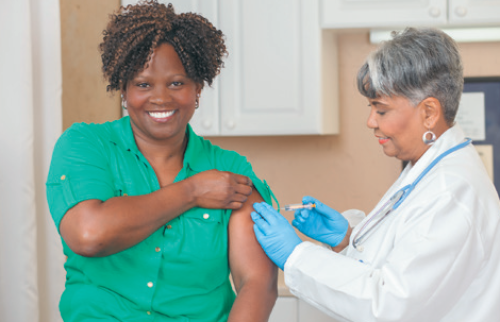For a condition as common as shingles—one in three people will get it at some point—there’s a surprising lack of awareness about symptoms, transmissibility, and prevention. There’s even a false news report circulating that links the virus with one of the COVID-19 vaccines. Let’s take a few moments to demystify this condition.
Signs and symptoms
Most commonly, shingles is a painful rash that occurs in people who have had chickenpox. It’s more common in people over age 50.
Typically, the first sign is a burning, stabbing, or aching pain on one side of the chest, abdomen, back, or waist. The degree of discomfort and people’s response to it runs the gamut from mild achiness for a week to unrelenting months-long intensive pain that makes even wearing a shirt difficult because the touch of fabric triggers a nerve-based response. In some people, it only itches.
Two or three days after the pain begins, about 75 percent of people develop a red bumpy rash that turns into blisters over the affected area. In some cases, the rash comes first, or both symptoms appear at once.
Under the surface
Shingles isn’t a new infection. Rather, it’s the reactivation of one you had in childhood: chickenpox. When you get chickenpox, your body fights off the varicella-zoster virus (VZV) that causes it, but it doesn’t vanquish the virus. Instead, VZV goes into hiding just outside of your spinal cord at the base of a nerve. There, it stays quietly hidden until a trigger causes it to reactivate and travel along a nerve path, causing the telltale band of pain and rash.
Women are more likely to get shingles than men, and Caucasians get shingles in greater numbers than African Americans. People with a weakened immune system have a higher risk of developing the condition and of experiencing severe symptoms and complications. This includes people who have cancer or HIV or who are being treated with immune-suppressing medications. Organ transplants, chemotherapy, rheumatologic conditions, and stress all increase the risk as well.
So while it behooves everyone to be aware of the signs and symptoms, if you are a white woman over 50 who is navigating a stressful life event or being treated with a drug that suppresses your immune system, you might want to be on high alert.
Contagious for only some people
People with no history of chickenpox or shingles vaccination can catch the VZV virus by being in close contact with an infected person. Transmission occurs through airborne droplets or direct contact with open blisters. Instead of developing shingles, though, they would develop chickenpox. If you’ve already had chickenpox, you can’t catch shingles from someone else: The VZV virus is already in you and may or may not reactivate. Likewise, you can’t spread shingles to someone who has had chickenpox.
Treatment
Shingles treatment is tricky because, although there are antiviral medications that can minimize the pain and the rash, valacyclovir and acyclovir, the drugs are effective only if they are administered within 72 hours of the initial onset of symptoms.
Other treatments are used to strictly treat the symptoms: Ibuprofen helps reduce pain, and cold compresses and oatmeal baths help soothe the rash and blisters. Some prescription pain medicines can help reduce discomfort, but even these are not guaranteed to provide relief.
The pain and rash usually subside within three to five weeks, but about 10 to 15 percent of people who get shingles have long-lasting pain, called postherpetic neuralgia (PHN), that can continue for three to six months or more. PHN is often likened to the sensation of an electric shock, but it can also feel numb.
Prevention
If you’re age 50 or older, you can likely avoid shingles with a vaccine called Shingrix, which is 91 to 97 percent effective at preventing shingles and PHN for at least four years. You should get the vaccine even if you are not sure if you had chickenpox, previously received the Zostavax shingles vaccine, or have already had shingles. (About 20 percent of people get it more than once.) There is no specific length of time that you need to wait after having shingles before you can receive Shingrix, but generally you should make sure the shingles rash has gone away and any pain has resolved before getting vaccinated.
The shingles vaccine is different from the chickenpox shot, even though both conditions are caused by VZV. The chickenpox vaccine is a live attenuated virus, meaning it stuns the live virus to make it non-infectious. If you have a severely suppressed immune system and get the chickenpox vaccine, you can get chickenpox, so it’s given only to healthy children who generally have robust immune systems. Shingrix, however, is not a live virus, so it is safe in people who have suppressed immune systems.


